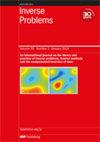具有两个考奇数据对的反导问题的 Lipschitz 稳定性
IF 2.1
2区 数学
Q1 MATHEMATICS, APPLIED
引用次数: 0
摘要
1996 年,Seo 证明了在平面均质物体表面测量的两对适当的电流和电压数据足以确定具有已知偏差电导率的导电多边形包络。在这里,我们证明了相应的线性化前向映射是注入式的,并由此推导出原始非线性逆问题解的 Lipschitz 稳定性。我们还处理了绝缘多边形包络的情况,在这种情况下,单对柯西数据就足以达到同样的目的。本文章由计算机程序翻译,如有差异,请以英文原文为准。
Lipschitz stability of an inverse conductivity problem with two Cauchy data pairs
In 1996 Seo proved that two appropriate pairs of current and voltage data measured on the surface of a planar homogeneous object are sufficient to determine a conductive polygonal inclusion with known deviating conductivity. Here we show that the corresponding linearized forward map is injective, and from this we deduce Lipschitz stability of the solution of the original nonlinear inverse problem. We also treat the case of an insulating polygonal inclusion, in which case a single pair of Cauchy data is already sufficient for the same purpose.
求助全文
通过发布文献求助,成功后即可免费获取论文全文。
去求助
来源期刊

Inverse Problems
数学-物理:数学物理
CiteScore
4.40
自引率
14.30%
发文量
115
审稿时长
2.3 months
期刊介绍:
An interdisciplinary journal combining mathematical and experimental papers on inverse problems with theoretical, numerical and practical approaches to their solution.
As well as applied mathematicians, physical scientists and engineers, the readership includes those working in geophysics, radar, optics, biology, acoustics, communication theory, signal processing and imaging, among others.
The emphasis is on publishing original contributions to methods of solving mathematical, physical and applied problems. To be publishable in this journal, papers must meet the highest standards of scientific quality, contain significant and original new science and should present substantial advancement in the field. Due to the broad scope of the journal, we require that authors provide sufficient introductory material to appeal to the wide readership and that articles which are not explicitly applied include a discussion of possible applications.
 求助内容:
求助内容: 应助结果提醒方式:
应助结果提醒方式:


